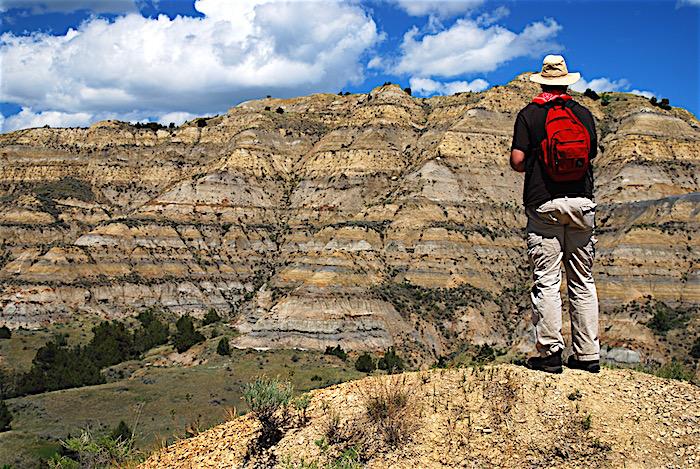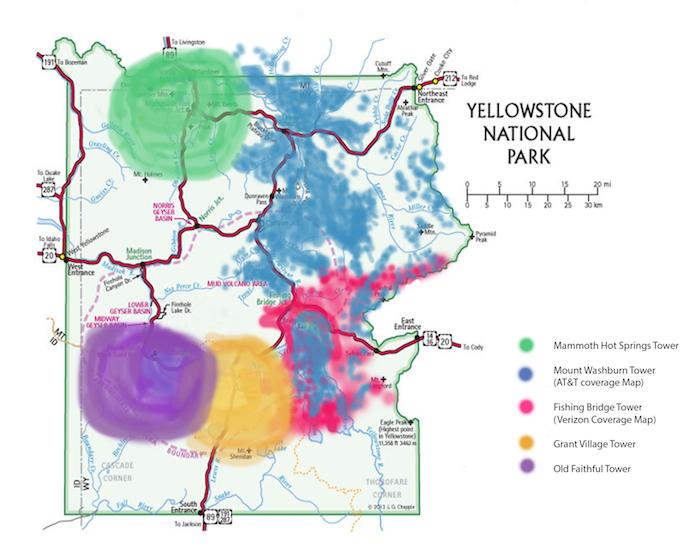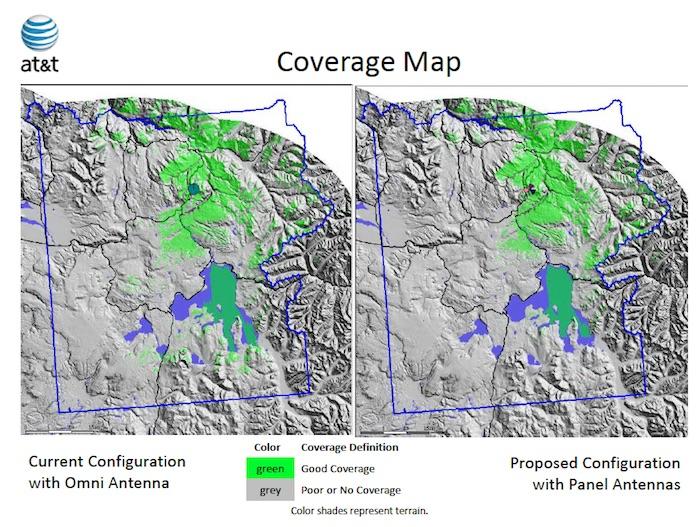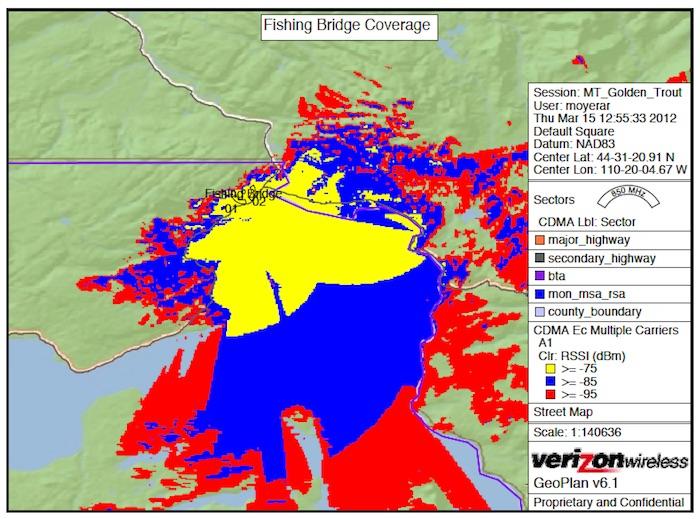
Can the National Park Service reduce cell phone service in the North Unit wilderness of Theodore Roosevelt National Park?/Kurt Repanshek file photo
If you carry a cell phone into a national park, should you expect connectivity? Many people would answer "yes." But what if you hiked into a wilderness area, which is supposed to be free of today's human technologies?
With more and more cell towers springing up around the country, the ability for managers in the National Park System to draw a hard line on where cell coverage flows is being taken out of their hands. So much so that President Lyndon B. Johnson's sentiments upon his signing of the Wilderness Act are increasingly difficult to hold up:
“If future generations are to remember us with gratitude rather than contempt, we must leave them something more than the miracles of technology. We must leave them a glimpse of the world as it was in the beginning, not just after we got through with it,” said President Johnson.
The ubiquitous nature of cell phones and their ability to be not just tools for calling but for taking photos, filming videos, recording sounds, plotting and following GPS coordinates, and measuring not just temperatures but also elevation and barometric pressure, have driven demands for connectivity.
For more than five decades, since passage of the Wilderness Act in 1964, land managers have grappled with what are appropriate experiences and "tools" in wilderness. Most notably in recent years, one topic drawing considerable debate involves the question of whether mountain bikes should be allowed in official wilderness, a thorny issue. But the use of cell phones in wilderness also is controversial, as Public Employees for Environmental Responsibility reminds us with their challenge to consideration by staff at Theodore Roosevelt National Park in North Dakota to share a communications tower with Verizon.

This is PEER's depiction of how much cell signal spillover exists in Yellowstone National Park, an interpretation park officials disagree with/PEER
“We don’t object to them replacing (the tower)," said PEER Executive Director Jeff Ruch, but “from what we could tell, this would blanket designated wilderness with cell phone coverage. ... There’s working with Verizon, and then there’s bending over with Verizon. As we just went through with Yellowstone, are they taking any steps to prevent spillover into wilderness? No.”
At Theodore Roosevelt, Superintendent Wendy Ross notes that no final decision has been reached on the question of sharing a cell tower with the communications giant. But she does point out that if the National Park Service declined Verizon's request, the company has looked at another location outside the park that would actually increase cell phone coverage in wilderness areas in her park's North Unit.
"It’s difficult to say what the impacts are on wilderness by having more cell phone coverage," she said during a phone conversation. ”You’d have less cell phone coverage in wilderness if you put that tower in the park than if you put it in their original location. That’s simply because it was a more optimal location that they had chosen at the get go. ... What does having more cell phone coverage in wilderness mean? How do you measure impacts to one resource against impacts to another, or perceived impacts to another.”
Bill Whitworth, Theodore Roosevelt's chief of resources, also noted that there already is cell phone coverage in the North Unit's wilderness as a result of cell towers located elsewhere outside the park, and in the South Unit's wilderness you also can find coverage.
Which brings us back to the question of how we should value officially designated wilderness and to what extent it should be shielded from today's technology. In January 2014, the National Park Service published Keeping It Wild in the National Park Service, a User Guide to Integrating Wilderness Character into Park Planning, Management, and Monitoring. In that 240-page document, the agency noted that, "There are a number of things on the horizon that could degrade opportunities for solitude or primitive and unconfined recreation. Unmitigated impacts of increased visitation, and increased availability and use of technology — from satellite phones to web cams to personal tracking devices — diminish solitude."
Yellowstone officials long have drawn PEER's ire over their dealings with cell phone coverage. Back in 2012, the advocacy group warned that "the electronic tendrils of cellular signals will penetrate even deeper into the heart of Yellowstone National Park if another cell tower receives final approval ...."
More recently, this past September, the group charged that much of Yellowstone's "wild backcountry" is reached by cell phone signals.
“The park has taken no step to limit backcountry coverage," Mr. Ruch claimed in that September release.

This map provided to the National Park Service depicts how AT&T intended to limit cell signal spillover from its antenna atop Mount Washburn/NPS
At Yellowstone, Bret De Young, the park's branch chief of technology services, doesn't think cell coverage spillover is as bad as PEER makes it out, but acknowledged during a phone call that there is some overreach of cell signals that needs to be reduced.
"We continue to work towards better meeting the intent of the (wireless) plan, moving away from the backcountry," said Mr. De Young. "Yes, there is spillover. ... We continue to make efforts to pull that in. Provide better service in developed areas but limit it elsewhere.”
Even in developed areas in Yellowstone, coverage can be spotty, he said.
"Whereas in the old days they took pictures with their Brownies, now they take pictures with their phones and maybe they want to upload it and store those photos or share them with friends and family," he said of park visitors. "Those (developed areas of the park) are places where we hope for them to be able to do that, where in the wild places, all of a sudden that signal goes away and they’re on their own. So I think we maintain a little bit of that."
At PEER, Mr. Ruch said his group's goal is to ensure the National Park Service protects official wilderness as mandated and that park managers follow the appropriate rules and regulations when it comes to considering cell phone and tower permits.
“We’re not anti-technology. We’re just trying to make sure park values and resources are adequately addressed in planning," he said during a phone call. "For example, in Yellowstone, if they were able to confined the signal as they said to developed areas, we wouldn’t be whining.”
But mapping of cell coverage indicates that two-thirds of the 2.2-million-acre park has service, according to PEER. Atop Mount Washburn at 10,243 feet, the fire lookout "looks like a telecommunications bunker," said Mr. Ruch. "Mount Washburn has gone from a scenic fire lookout to this monstrosity.”
That should change in the future, said Mr. De Young.
“We’ve been working for many years on getting antennas off of Mount Washburn, the fire lookout, and onto a structure. We’re having a really hard time coming up with something that doesn’t look like an antenna on top of a mountain," he said. “We’re hoping to move those panels off of Mount Washburn and do more directional signals. … Mount Washburn is so high, the spillover there is really hard to control. Most of our towers are 70 to 100 feet high, and you can keep them more like a microsite, but when you’re up at 10,000 feet, you can’t really.”

This map provided by Verizon shows cell signal coverage from its antenna at Fishing Bridge on the north end of Yellowstone Lake/NPS
Over at Theodore Roosevelt, Mr. Ruch hopes park managers, if they approve a tower with room for Verizon, are successful in seeing the signals are directional and don't flood out over the official wilderness in the North Unit of the park.
“Our NEPA compliance isn’t done yet," said Superintendent Ross. "And we still have the (Verizon) application for the right-of-way. We can say no. A decision hasn’t been made. If new information comes to light, now that the public comment period is closed, we can take those comments, look at our NEPA, and make sure it's sufficient.”
Superintendent Ross did say, in addition, that she would check with Verizon to see if their signals could be directed away from her park's wilderness.
But even if it can be, what of the next generation of technology? Already there are apps that don't need cell service to function when you're off-the-grid, instead relying on satellite signals. How should we measure, and protect, wilderness qualities in the 21st century?



Comments
Gee, Rick. You just confessed to being almost as OLD as I am!
We do not know if:
cell phone or any other technology that has no impact on other users
We do know it has an impact on things
And I always will be ALMOST as old as you, Lee.
Y'got me there, Rick. Keep smiling!
I created and developed a federal antenna program within a property-holding federal agency designated as the lead agency to implement wireless siting on federal facilities. The program was a roaring success and I became the federal "expert" on siting wireless antennas on federal property for many years, being a resource to other agencies, and state and local Govts.
Many historic buildings in Wash DC and all over the US have wireless antennas that are heavily "stealthed" and there are industry partners that specialize in making antennas "disappear". The local Fine Arts and State Historic Preservation entities approved these installations in and around DC. It is a public safety and worker safety issue for visitors and employees of the parks, and to allow / promote wireless coverage is the responsible thing to do. It CAN be a matter of life or death. It need not be ugly, nor look like a large toilet brush, as do some cell towers specially designed to look like trees. It is an uninformed choice to allow ONE wireless provider to locate in any park, when there are Neutral Host Provider companies that have done dozens of local parks, suburban settings and urban settings with antenna SYSTEMS that are stealthed and well hidden. These Neutral Host Providers are not telecomm carriers at all, but provide the technological platform, infrastructure, financing and oversight so that all carriers are able to function on ONE, integrated system. They do not deploy very large ugly antennas, giant spheres ( latest ATT technology) or 5 ft wide panels to accomplish their coverage. These companies are "integrators" who have existing relationships with the telecomm carriers nationwide, and they work hand-in-glove on these sensitive, aesthetic projects that bring wireless coverage to the masses anywhere with grace and efficiency. UNFORTUNATELY, the National Park Service has yet to allow such companies to operate on federal lands under their purview, due to outdated, inapplicable, last-century thinking and iron clad, inflexible policies. But the winds of change are beginning to blow a little harder, sweeping along new ways of thinking and new approaches based on needs / wants of the public. After all, that's what drives alot of things in this country. Don't succumb to uninformed PEER pressure and narrow thinking.
I'm gonna go ahead and disagree with almost every other comment here. Wilderness managers have an obligation to protect the unique wilderness values of their unit, and one of those values is "opportunities for solitude or primitive and unconfined recreation".
How does being connected to the entire planet via internet contribute to "solitude"? How does immediate access to Spotify contribute to "primitive recreation"? Y'all are saying, "I feel so vulnerable knowing I can't call emergency services at a moment's notice." Please show me where in the Wilderness Act it says that you should be able to call 911 if you stub your toe or your can opener breaks. One of the preeminent benefits of wilderness is that you have to rely on your own two hands to solve problems experienced by humans for millenia. Yes, there's some pain, fear, uncertainty, discomfort. Welcome to the wild, where man's insignificance is apparent and where we are reminded that we are not above the animals with whom we share this earth.
If you want connectivity, go to any of the other millions of acres of public land that don't have a mandate to provide solitude or primitive recreation. If you want safety and peace of mind, go car camping at a state park. If you want endless entertainment, go to Vegas. Wilderness is a refuge from all that crap, and if you can't appreciate it, leave it to those of us who can.
If my can opener breaks I deal with it like you do. If my femur breaks I'll need some help, regardless of what the Wilderness Act, the Bagavad Gita, or the playbill from 42nd Street says. I haven't downloaded Spotify yet, but thanks for the recommendation.
Elitist hand wringing at its best!